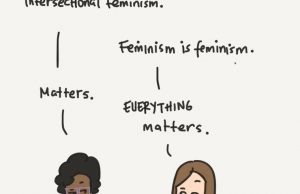An Alert: Capital is Intersectional; Radicalizing Piketty’s Inequality
By Zillah Eisenstein
 When civil rights activists speak about race they are told they need to think about class as well. When anti-racist feminists focus on the problems of gendered racism they are also told to include class. So—I will continue this discussion with: when formulating class inequality one should have race and gender in view as well.
When civil rights activists speak about race they are told they need to think about class as well. When anti-racist feminists focus on the problems of gendered racism they are also told to include class. So—I will continue this discussion with: when formulating class inequality one should have race and gender in view as well.
Capital is intersectional. It always intersects with the bodies that produce the labor. Therefore, the accumulation of wealth is embedded in the racialized and engendered structures that enhance it. Thomas Piketty’s Capital in the Twenty-First Century reads as though labor has no actual body—no home that actually creates it. It remains abstract and therefore colorless as in white, and sexless as in male.
Piketty documents the increased importance of inherited wealth and therefore the lessening of meritocracy. He presents huge amounts of data to prove the fact that inequality is more inherited than earned; and will not self-correct. He is troubled with the excessive aspects of inequality rather than inequality in and of itself. I wonder, what is too much inequality and who gets to define this? But I also wonder why, in the 21st century, should we define capital and inequality as though they are singular phenomena?
Piketty humbly acknowledges that his book is incomplete and imperfect. He also says “the way one tries to measure inequality is never neutral.” Precisely. Piketty says “expert analysis will never put an end to the violent political conflict that inequality inevitably instigates” (p.3). Let me start, so to speak, where he ends and open the discussion of inequality and capital for the 21st century a bit differently.
He says that that the way wealth is accumulated and distributed will continue to create divergence (p. 27). Piketty thinks that population growth deeply influences wealth and therefore capital, but yet there is no recognition of the sexual reproductive labor that is the source of population growth. He shows that global population growth peaked in the 1950s-70s. These were key years of women’s “domesticity”—enormous hours of free/stolen domestic labor for capital of women of all colors.
I am sure that available “data” is a problem. But there is enough data on the “value” of invisible and unpaid domestic labor to make more inclusive findings about excessive inequality in terms of the sexual division of labor. We need more imagination in this instance to also include the “unequal” value of labor according to sex, race and gender that enhances inequality and capital. Piketty is critical in allowing data to dominate one’s imagination. I fear that although he dislikes the scientificity of economists he is held hostage by it in the end.
Piketty focuses much of the book in Europe and the U.S. and on the 18th century. There is a problem here. The 18th century is greatly defined by the slave trade and yet there is no analysis of how capital accumulation and ex-slave labor, or ex-slave rape complexly feed each other here. Ex-slaves are recognized as property and adding to capital in this way. They are accounted for in terms of “total market value.” But their labor as such goes unrecognized as creating further capital. And there is no recognition of the sexual reproduction of labor by Black enslaved women, so often by rape, as part of market value, or capital.
Piketty recognizes that brutal racial inequality persists today but it has no specific standing in relation to capital. Sexual trafficking today that both reflects the brutality of economic inequality and contributes with stolen labor and lives to the very structuring of global capital, remains unrecognized and silenced.
Piketty says, “capital is not an immutable concept” (p. 47); that it reflects prevailing social relations. This is why patriarchy and racism is key to this understanding. Labor—the other side of capital—comes in colors and sexes and genders and is formulated through new expressions of power. Racialized, sexualized and gendered labor contributes to capital accumulation and structures the inequality that emanates from it.
Excessive economic inequality is always further enhanced by racial and gender configurations. The inequality is not simply excessive; it is particularly excessive according to color and sex. Whiteness and maleness is a form of power and therefore potentially, regenerative of capital. Rich and poor nations are changing in relation to each other because of the new levels of inequality and therefore so are their colorings and gendering.
It is time for a more inclusive understanding of the economy, of capital, of profit, of inequality. Without it there cannot be justice for humanity in its entirety—with people of all colors and genders and sexes. The problem of inequality is structured by both racist divisions of labor and culture, and patriarchal constructs of violence and exploitation. Each time Pope Francis is embraced for his new democratic initiatives about economic inequality, or Piketty’s book is said to be brilliant and instructive for the future, peoples of all colors, and especially women among them, are silenced.
We are witnessing the chaos of capital(ism) with its new excesses of the 1%. The “Occupy”(Wall Street) movement put the unfairness of this regime in view. It is now past due to start connecting the parts—between global capitalism, gross inequality, and sexual/gendered and racial oppression. Singularly, they remain piecemeal and protected.
The present chaos in part derives from the newest forms of labor — from service, to cyber, to unpaid domestic, to transnational caregiving, and so forth. Patriarchal exploitation takes on new/old forms as labor itself derives more and more from female bodies that are the newest migrants of the globe. New levels of violence travel from private and familial sites to more public work places. The violence, and particularly sexual violence, underwrites the exchange process.
In this past week the largest fast food strike in the history of the world was started—from New York City to New Zealand to Brazil–demanding the living wage of $15 dollars an hour. Disproportionate numbers of the demonstrators are women of all colors. These women make up the newest proletariat of this globe; and are the biggest resource for capital. They strike against a 200 billion dollar industry asking for an end to excessive greed, especially of the CEO’s. As well, remember the Rana Plaza building in Savar, Bangladesh where thousands of garment workers, mostly women, died horrible deaths, or were gravely injured. Yet, the devastation continues to encompass men’s lives too. Soma, Turkey is still reeling from the deaths of more than 300 coal miners who died simply because of out-of-control greed.
At this writing, 276 girls who were abducted in Chibok, Nigeria remain missing. They are, unimaginable pawns in a world filled with grotesque misogynist inequality and capitalist voraciousness. Nigeria suffers the excesses of poverty for too many while the country continues to be the largest oil producer in Africa. Boko Haram persists within a surround of poverty and thuggery. Great wealth alongside grinding poverty colludes with a horrific misogyny that defines girls as part of the trafficking of sexual labor and their bodies.
Capital and inequality in the 21st century cannot be abolished without addressing its racist history through chattel slavery—especially if the data for Europe and the U.S. largely derives from the 18th century with its patriarchal history of misogynist practices, including slavery.
Invisibility of the labor(s) of all sorts done by women of all colors must be named and abolished for new egalitarian labor forms. By naming the invisible and hidden we move toward a more democratic inclusivity. Everything—labor, capital, lived lives are complex wholes. Viewing the simplicity/singularity of inequality protects it. If all labor, and therefore capital derives from toiling bodies then multiplicity and intersectionality and complexity must underpin any imaginings for a real democracy.
Economic inequality should not be abstracted from the very personally experienced politics of raced and sexed and gendered bodies. Humanity is as complex as each and every one of us—and each of us is simultaneously multiple and overlapping in our being.
Piketty ends his book saying that we must risk everything in order to reinvent our thinking and get a hold of the run away capitalist train. But he does not risk enough. I will err on the side of the imperfection and incompleteness that he speaks of. If we are going to abolish excessive inequality we need an anti-racist socialist feminist revolution that is filled with new imaginings that we have not thought of yet. Meanwhile, I will agree with him that we can start with really taxing the rich.
___________________________________
 Zillah Eisenstein has been a Professor of Politics at Ithaca College in New York for the past 35 years and is now “Distinguished Scholar in Residence” there. Besides her recently published THE AUDACITY OF RACES AND GENDERS: A PERSONAL AND GLOBAL STORY OF THE OBAMA CAMPAIGN (2009, Zed Press, London; Palgrave, U.S.), her books include among others: SEXUAL DECOYS, GENDER, RACE AND WAR IN IMPERIAL DEMOCRACY (London, Zed Press; New York, Palgrave, 2007); AGAINST EMPIRE, ibid.; HATREDS: RACIALISED AND SEXUALIZED CONFLICTS IN THE 21ST CENTURY, (Routledge, 1996); GLOBAL OBSCENTITIES: PATRIARCHY, CAPITALISM AND THE LURE OF CYBERFANTASY (NYU PRESS, 1996); and MANMADE BREAST CANCERS, (Cornell Univ. Press, 2001). For more information see:www.ithaca.edu/zillah.
Zillah Eisenstein has been a Professor of Politics at Ithaca College in New York for the past 35 years and is now “Distinguished Scholar in Residence” there. Besides her recently published THE AUDACITY OF RACES AND GENDERS: A PERSONAL AND GLOBAL STORY OF THE OBAMA CAMPAIGN (2009, Zed Press, London; Palgrave, U.S.), her books include among others: SEXUAL DECOYS, GENDER, RACE AND WAR IN IMPERIAL DEMOCRACY (London, Zed Press; New York, Palgrave, 2007); AGAINST EMPIRE, ibid.; HATREDS: RACIALISED AND SEXUALIZED CONFLICTS IN THE 21ST CENTURY, (Routledge, 1996); GLOBAL OBSCENTITIES: PATRIARCHY, CAPITALISM AND THE LURE OF CYBERFANTASY (NYU PRESS, 1996); and MANMADE BREAST CANCERS, (Cornell Univ. Press, 2001). For more information see:www.ithaca.edu/zillah.




Pingback: Alert: Capital is Intersectional; Radicalizing Piketty”s Inequality | Zillah Eisenstein